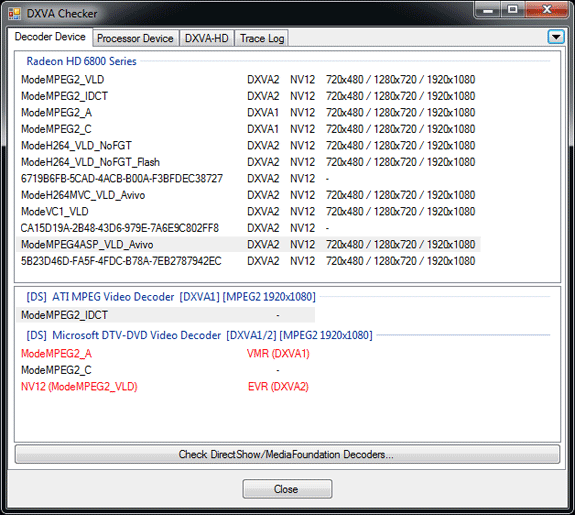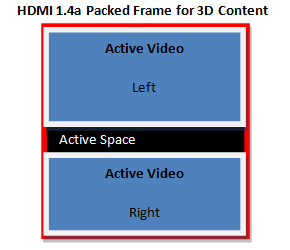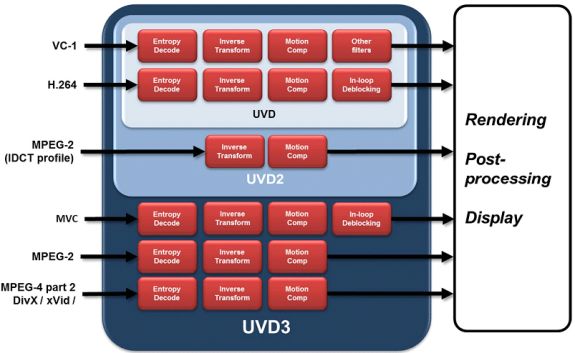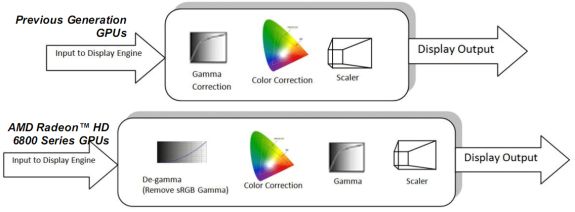AMD’s Radeon HD 6870 & 6850: Renewing Competition in the Mid-Range Market
by Ryan Smith on October 21, 2010 10:08 PM ESTSeeing the Present: HDMI 1.4a, UVD3, and Display Correction
DisplayPort wasn’t the only aspect of AMD’s display controller that got an overhaul however, AMD’s HDMI capabilities have also been brought up to modern standards. Coming from Cypress with support for HDMI 1.3, AMD now supports HDMI 1.4a on the Barts based 6800 series and presumably they will do so on the rest of the 6800 series too. With HDMI 1.4a support AMD can now support full resolution (1080p) 3D stereoscopy for movies, and 720p for games and other material that require 60Hz/eye, along with 4k x 2k resolution for monitors and TVs that have equivalent support. Unlike DP this has less to do with monitors and more to do with TVs, so the importance of this will be seen more on future AMD cards when AMD refreshes their lower-end parts that we normally use with HTPCs.
Launching alongside support for displaying full resolution 3D stereoscopic video is the hardware necessary to decode such video, in the form of the latest version of AMD’s Unified Video Decoder: UVD3. The last time UVD received a major update was with UVD2, which launched alongside the Radeon HD 4000 series and added partial MPEG-2 decoding support by moving IDCT and MoComp from shaders in to the UVD fixed function hardware.
With the Radeon 6800 series AMD is releasing UVD3, which like UVD2 before it builds on the existing UVD feature set. UVD3 is adding support for 3 more-or-less new codecs: MPEG-2, MVC, and MPEG-4 ASP (better known as DivX/XviD). Starting with MPEG-4 ASP, it’s the only new codec in supported by UVD3 that’s actually new, as previously all MPEG-4 ASP decoding was done in software when it came to AMD GPUs. With UVD3 AMD can now completely offload MPEG-4 ASP decoding to the GPU, bringing forth the usual advantages of greatly reducing the amount of work the CPU needs to do and ideally reducing power consumption in the process.
AMD adding MPEG-4 ASP support gives us an interesting chance to compare and contrast them to NVIDIA, who added similar support a year ago in the GT21x GPUs. AMD is a good bit behind NVIDIA here, but they’re making up for it by launching with much better software support for this feature than NVIDIA did; NVIDIA still does not expose their MPEG-4 ASP decoder in most situations, and overall did a poor job of advertising it. When we talked with DivX (who is AMD’s launch partner for this feature) they didn’t even know that NVIDIA had MPEG-4 ASP support. Meanwhile AMD is launching with DivX and had a beta version of the DivX codec with UVD3 support ready to test, and furthermore AMD is fully exposing their MPEG-4 ASP capabilities in their drivers as we see in this DXVA Checker screenshot.

The only downside at this time is that even with Microsoft’s greater focus on codecs for Windows 7, Windows 7 doesn’t know what to do with DXVA acceleration of MPEG-4 ASP. So while Win7 can play MPEG-4 ASP in software, you’re still going to need a 3rd party codec like the DivX codec to get hardware support for MPEG-4 ASP.
The other bit worth mentioning is that while AMD is launching support for MPEG-4 ASP decoding here on the 6800 series, much like HDMI 1.4a it’s not going to be a big deal for the 6800 series market. MPEG-4 ASP is a fairly lightweight codec, so support for it is going to be a bigger deal on low-end products, particularly AMD’s APUs if Llano and Bobcat end up using UVD3, as MPEG-4 ASP decoding in software requires a much greater share of resources on those products.
Up next is MPEG-2, which has been a codec stuck in limbo for quite some time over at AMD. MPEG-2 is even older and easier to decode than MPEG-4 ASP, and while GPUs have supported MPEG-2 decode acceleration as early as last decade, CPUs quickly became fast enough that when combined with low levels of hardware decode acceleration (inverse discrete cosine transform) was more than enough to play MPEG-2 content. Thus AMD hasn’t done much with MPEG-2 over the years other than moving IDCT/MoComp from the shaders to UVD for UVD2.
Because of the similarities between MPEG-4 ASP and MPEG-2, when AMD added support for full MPEG-4 ASP decode acceleration they were able to easily add support for full MPEG-2 decode acceleration, as they were able to reuse the MPEG-4 ASP entropy decode block for MPEG-2. As a result of including full MPEG-4 ASP decode acceleration, AMD now supports full MPEG-2 decode acceleration. Even more so than MPEG-4 ASP however, the benefits for this are going to lie with AMD’s low-end products where getting MPEG-2 off of the CPU should be a boon for battery life.

The final addition to UVD3 is support for Multiview Video Coding, which isn’t a new codec per se, but rather is an extension to H.264 for 3D stereoscopy. H.264 needed to be amended to support the packed frame formats used to store and transmit 3D stereoscopic videos, so with UVD3 AMD is adding support for MVC so that UVD can handle Blu-Ray 3D.
Finally, coupled with support for new codecs and new display outputs in AMD’s display controller is a refinement of AMD’s existing color correction capabilities in their display controller. Cypress and the rest of the 5000 series could do color correction directly on their display controllers, but they could only do so after gamma correction was applied, meaning they had to work in the non-linear gamma color space. Technically speaking this worked, but color accuracy suffered as a result. With the 6800 series’ new display controller, AMD can now perform color calibration in linear space by converting the image from gamma to linear color space for the color correction, before converting it back to gamma color space for display purposes.
As color correction is being used to correct for wide-gamut monitors the importance of this change won’t be seen right away for most users, but as wide-gamut monitors become more widespread color correction becomes increasingly important since wide-gamut monitors will misinterpret the normal sRGB colorspace that most rendering is done in.












197 Comments
View All Comments
Donkey2008 - Friday, October 22, 2010 - link
Can you provide a link to your website so I can read your review of the cards? That would be awesome.Natfly - Friday, October 22, 2010 - link
Sure, right here: http://tinyurl.com/36ag36dBlendMe - Friday, October 22, 2010 - link
So you're telling me I can get two 6870 and spend lest money, use less power and have more performance than a GTX 480? I like the idea of going back to what made the 48xx cards so great. Small, cheap and expandable.Can't wait for the rest of the line up.
tpurves - Friday, October 22, 2010 - link
how is it that the nvidia cards go UP in framerate when you increase the resolution from 1650 to 1920 and add 4xAA? Did you mix up some test run numbers?mapesdhs - Friday, October 22, 2010 - link
It's a pity the charts don't include SLI results for the EVGA 460. I would like to have seen
how close it came to 470 SLI, given the 470s inferior power, GPU load temp and noise
results. The 470 GPU load temps under Crysis for just one card are particularly scary;
the idea of using two 470s SLI, and even more so oc'ing them, seems like a recipe for
thermal mayhem - alien astronomers with IR telescopes would wonder what the heck
they've spotted. :D
The price drop on the 470 is interesting, but the EVGA 460 still looks like a better buy
because of the power/heat issues, especially so for those considering SLI (as I am),
and also the fact that the EVGA is as good or better than the 6870. This graph is the
one that interests me:
http://images.anandtech.com/graphs/graph3987/33232...
The stock 460 SLI is clearly nowhere near as good as 6870 CF or 470 SLI, but given
a single EVGA 460 matches the 6870, I'd really like to know how two EVGAs perform.
Any chance you could add the data later?
On the other hand, one could assume the 6870 should have some oc'ing headroom,
but toms' review didn't show that much of a gain from oc'd 6870s.
The 6870 here in the UK seems to be about 200 UKP (Aria, Scan), though the XFX
version looks to be an exception (178 from Scan). The EVGA is 174 (Scan, but no
stock yet). For those who don't want to spend that much, the 800MHz Palit Sonic
Platinum 460 has dropped down to only 163 (last week it was 183). I almost bought
two of the Palit cards last week, so I'm glad I waited.
Obviously the pricing is all over the place atm, and likely to wobble all over again
when the next 6xxxx cards are released. Either way, despite the lack of major
performance increases atm, at least there's finally some pricing/value competition.
I think I'll wait until the dust settles re pricing, then decide. Quite likely many others
will do the same.
Ian.
AtenRa - Friday, October 22, 2010 - link
Why did you run at 1920x1200 and not 1920x1080 ??most 1920x1200 monitors are extincted from the market and 1920x1080 is becoming the defacto resolution.
Lunyone - Friday, October 22, 2010 - link
Well with bowing down to nVidia on the selection of "what" GPU to use, you have lost all credibility in my eyes. Even Tom's Hardware took a higher road and agreed to use the "hand picked" GPU, but limited the clocks to near stock settings, so there was a more "real" world comparison. Who nows if this isn't the first time that this has happened at Anandtech. I notice no rebuttals on Anand's part, so I'm guessing that they are quite amazed that people are seeing how one sided this issue is. This article wouldn't affect my purchase, since I look a several sites to draw a conclusion from. But my confidence in quality and fair reporting from Anandtech's reviews have been compromised, IMHO. I don't know if I will put any merit to any on Anand's reviews, time will tell.Sunburn74 - Friday, October 22, 2010 - link
Gee. You know whats all this about Anandtech losing credibility? Nvidia specifically asked them to test one card and the consumer benefits from having this information. Its not like anandtech didn't include the reference gtx460 as well. Anything that tells the consumer more about how valuable his dollar really is, is a good thing imo.I currently have an oced radeon 5850 and it annoyed the hell out of me trying to justify whether or not the extra 30 bucks I eventually ended up paying for it, was worth it. There weren't any reviews at the time you see...
SandmanWN - Friday, October 22, 2010 - link
You can't gauge value of an overclocked card against a stock card. You have no idea what the other card can do. What you are saying is nonsense if you really put two seconds into thinking about what you just said.mindbomb - Friday, October 22, 2010 - link
we are talking about factory oc'd cards.It's not like Anand was playing around in rivatuner.